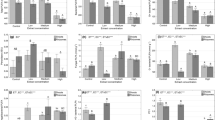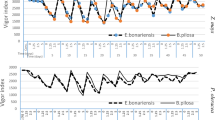Abstract
Garlic mustard’s (Alliaria petiolata, Brassicaceae) invasive success is attributed in part to its release of allyl isothiocyanate (AITC) into the soil. AITC can disrupt beneficial arbuscular mycorrhizal fungi (AMF) associated with native plant roots, which limits their soil resource uptake. However, AITC and its precursor, sinigrin, have never been detected in garlic mustard-invaded forest soils. Here, we use high performance liquid chromatography (HPLC) and gas chromatography-mass spectrometry (GC–MS) to assess the concentration and bioactivity of these putative allelochemicals in paired forest plots uninvaded or invaded by garlic mustard. Our methods detected AITC and sinigrin only where garlic mustard was present and our recovery of AITC/sinigrin coincided with adult senescence. A bioassay of in situ fungal hyphae abundance revealed significantly reduced hyphal abundance in the presence of garlic mustard relative to uninvaded soils. Finally, the lowest concentration of AITC measured in the field (~0.001 mM) is highly inhibitory to the spore germination of a forest AMF species, Glomus clarum. Together, our data provide the first direct evidence of garlic mustard-produced sinigrin and AITC in forest soils and demonstrate that even low levels of these chemicals have the potential to significantly suppress AMF growth and spore germination, strengthening their status as allelopathic novel weapons.




Similar content being viewed by others
References
Agerbirk N, Petersen B, Olsen CE, Halkier BA, Nielson JK (2001) 1, 4-Dimethoxyglucobrassicin in Barbarea and 4-hydroxyglucobrassicin in Arabidopsis and Brassica. J Agric Food Chem 49:1502–1507
Anderson RC, Dhillion SS, Kelley TM (1996) Aspects of the ecology of an invasive plant, garlic mustard (Alliaria petiolata), in central Illinois. Restor Ecol 4:181–191
Anderson RC, Anderson MR, Bauer JT, Slater M, Herold J, Baumhardt P, Borowicz V (2010) Effect of removal of garlic mustard (Alliaria petiolata, Brassicaeae) on arbuscular mycorrhizal fungi inoculum potential in forest soils. Open Ecol J 3:41–47
Baláz M, Vosátka M (2001) A novel inserted membrane technique for studies of mycorrhizal extraradical mycelium. Mycorrhiza 11:291–296
Barto EK (2008) An assessment of the allelopathic potential of Alliaria petiolata. Dissertation, Wright State University
Barto EK, Cipollini D (2009a) Density-dependent phytotoxicity of Impatiens pallida plants exposed to extracts of Alliaria petiolata. J Chem Ecol 35:495–504. doi:10.1007/s10886-009-9629-1
Barto EK, Cipollini D (2009b) Half-lives and field soil concentrations of Alliaria petiolata secondary metabolites. Chemosphere 76:71–75
Barto EK, Powell JR, Cipollini D (2010a) How novel are the chemical weapons of garlic mustard in North American forest understories? Biol Invasions. doi:10.1007/s10530-010-9744-5
Barto K, Friese C, Cipollini D (2010b) Arbuscular mycorrhizal fungi protect a native plant from allelopathic effects of an invader. J Chem Ecol 36:351–360
Blair AC, Leslie A, Weston LA, Nissen SJ, Brunk GR, Hufbauer RA (2009) The importance of analytical techniques in allelopathy studies with the reported allelochemical catechin as an example. Biol Invasions 11:325–332. doi:10.1007/s10530-008-9250-1
Borek V, Morra MJ, Brown PJ, McCaffery JP (1995) Transformation of the glucosinolate-derived allelochemicals allyl isothiocyanate and allylnitrile in soil. J Agric Food Chem 43:1935–1940
Brown PD, Morra MJ (1997) Control of soil-borne plant pests using glucosinolate-containing plants. Adv Agron 61:167–231
Brundrett M, Kendrick B (1988) The mycorrhizal status, root anatomy, and phenology of plants in a sugar maple forest. Can J Bot 66:1153–1173
Brundrett M, Kendrick B (1990) The roots and mycorrhizas of herbaceous woodland plants. I. Quantitative aspects of morphology. New Phytol 114:457–468
Burke DJ (2008) Effects of Alliaria petiolata (garlic mustard; Brassicaceae) on mycorrhizal colonization and community structure in three herbaceous plants in a mixed deciduous forest. Am J Bot 95:1416–1425
Callaway RM, Aschehoug ET (2000) Invasive plants versus their new and old neighbors: a mechanism for exotic invasion. Science 290:521–523
Callaway RM, Ridenour WM (2004) Novel weapons: invasive success and the evolution of increased competitive ability. Front Ecol Environ 2:436–443
Callaway RM, Cipollini D, Barto K, Thelen GC, Hallett SG, Prati D, Stinson K, Klironomos J (2008) Novel weapons: Invasive plant suppresses fungal mutualists in America but not in its native Europe. Ecology 89:1043–1055
Choesin DN, Boerner REJ (1991) Allyl isothiocyanate release and the allelopathic potential of Brassica napus (Brassicaeae). Am J Bot 78:1083–1090
Cipollini D (2002) Variation in the expression of chemical defenses in Alliaria petiolata (Brassicaeae) in the field and common garden. Am J Bot 89:1422–1430
Cipollini D, Gruner B (2007) Cyanide in the chemical arsenal of garlic mustard, Alliaria petiolata. J Chem Ecol 33:85–94
Feeny P, Rosenberry L (1982) Seasonal variation in the glucosinolate content of North American Brassica nigra and Dentaria species. Biochem Syst Ecol 10:23–32
Gimsing AL, Kirkegaard JA (2006) Glucosinolate and isothiocyanate concentration in soil following incorporation of Brassica biofumigants. Soil Biol Biochem 38:2255–2264
Giovannetti M, Mosse B (1980) An evaluation of techniques for measuring vesicular arbuscular mycorrhizal infection in roots. New Phytol 84:489–500
Gols R, Raaijmakers CE, van Dam NM, Dicke M, Bukovinszky T, Harvey JA (2007) Temporal changes affect plant chemistry and tritrophic interactions. Basic Appl Ecol 8:421–433
Haribal M, Renwick JAA (1998) Isovitexin 6″-O-β-D-glucopyranoside: a feeding deterrent to Pieris napi oleracea from Alliaria petiolata. Phytochemistry 47:1237–1240
Haribal M, Renwick JAA (2001) Seasonal and population variation in flavonoid and alliarinoside content of Alliaria petiolata. J Chem Ecol 27:1585–1594
Haribal M, Yang Z, Attygalle AB, Renwick JAA, Meinwald J (2001) A cyanoallyl glucoside from Alliaria petiolata as a feeding deterrent for larvae of Pieris napi oleracea. J Nat Prod 64:440–443
Harris DC (2003) Quantitative chemical analysis. W. H. Freeman and Company, New York
He W-M, Feng Y, Ridenour WM, Thelen GC, Pollock JL, Diaconu A, Callaway RM (2009) Novel weapons and invasion: biogeographic difference in the competitive effects of Centaurea maculosa and its root exudates (±) catechin. Oecologia 159:803–815
Hierro JL, Callaway RM (2003) Allelopathy and exotic plant invasions. Plant Soil 256:29–39
Inderjit, Weiner J (2001) Plant allelochemical interference or soil chemical ecology? Perspect Plant Ecol Evol Syst 4:3–12
Inderjit, Dakshini KMM (1999) Bioassays for allelopathy: interactions of soil organic and inorganic constituents. In: Inderjit, Dakshini KMM, Foy CL (eds) Principles and practices in plant ecology: allelochemical interactions. CRC Press LLC, Boca Raton, FL, pp 35–44
Inderjit, Pollock JL, Callaway RM, Holben W (2008) Phytotoxic effects of (±)-catechin in vitro, in soil, and in the field. PLoS ONE 3:e2536. doi:10.1371/journal.pone.0002536
Klironomos JN, Hart M (2002) Colonization of roots by arbuscular mycorrhizal fungi using different sources of inoculum. Mycorrhiza 12:181–184
Lankau R (2010) Soil microbial communities alter allelopathic competition between Alliaria petiolata and a native species. Biol Invasions 12:2059–2068. doi:10.1007/s10530-009-9608-z
Lankau RA, Nuzzo V, Spyreas G, Davis AS (2009) Evolutionary limits ameliorate the negative impact of an invasive plant. Proc Natl Acad Sci USA 106:15362–15367
Lind EM, Parker JD (2010) Novel weapons testing: Are invasive plants more chemically defended than native plants? PLoS ONE 5:e10429. doi:10.1371/journal.pone.0010429
McCarthy BC, Hanson SL (1998) An assessment of the allelopathic potential of the invasive weed Alliaria petiolata (Brassicaceae). Castanea 63:68–73
Merryweather J, Fitter A (1995) Phosphorus and carbon budgets: mycorrhizal contribution in Hyacinthoides non-scripta (L.) Chouard ex Rothm. under natural conditions. New Phytol 129:619–627
Nuzzo VA (1993) Distribution and spread of the invasive biennial Alliaria petiolata (Bieb. [Cavara and Grande]) in North America. In: McKnight BL (ed) Biological pollution: Control and impact of invasive exotic species. Indiana Academy of Science, Indianapolis, pp 115–124
Nuzzo V (2000) Element stewardship abstract for Alliaria petiolata (Alliaria officinalis), garlic mustard. The Nature Conservancy, Arlington, p 19
Olivier C, Vaughn SF, Mizubuti ESG, Loria R (1999) Variation in allyl isothiocyanate production within Brassica species and correlation with fungicidal activity. J Chem Ecol 25:2687–2701
Orr SP, Rudgers JA, Clay K (2005) Invasive plants can inhibit native tree seedlings: testing potential allelopathic mechanisms. Plant Ecol 181:153–165
Prati D, Bossdorf O (2004) Allelopathic inhibition of germination by Alliaria petiolata (Brassicaceae). Am J Bot 91:285–288
Rice EL (1974) Allelopathy. Academic Press, New York
Roberts KJ, Anderson RC (2001) Effect of garlic mustard [Alliaria petiolata (Beib. Cavara & Grande)] extracts on plants and arbuscular mycorrhizal (AM) fungi. Am Midl Nat 146:146–152
Rodgers V, Stinson KA, Finzi AC (2008) Ready or not, garlic mustard is moving in: Alliaria petiolata as a member of eastern North American forests. Bioscience 58:426–436
Stein SE (2005) Mass spectra. In: Linstrom PJ, Mallard WG (eds) NIST Standard Reference Database Number 69: NIST chemistry WebBook. National Institute of Standards and Technology, http://webbook.nist.gov/cgi/inchi/InChI%3D1S/C4H5NS/c1-2-3-5-4-6/h2H%2C1%2C3H2. Accessed 17 Aug 2010
Stinson KA, Campbell SA, Powell JR, Wolfe BE, Callaway RM, Thelen GC, Hallet SG, Prati D, Klironomos JN (2006) Invasive plant suppresses the growth of native tree seedlings by disrupting belowground mutualisms. PLoS Biol 4:727–731
Thorpe AS, Thelen GC, Diaconu A, Callaway RM (2009) Root exudate is allelopathic in invaded community but not in native community: field evidence for the novel weapons hypothesis. J Ecol 97:641–645
Tsao R, Yu Q, Friesen I, Potter J, Chiba M (2000) Factors affecting the dissolution and degradation of oriental mustard-derived sinigrin and allyl isothiocyanate in aqueous media. J Chem Ecol 48:1901–1902
van der Heijden MGA, Bardgett RD, van Straalen NM (2008) The unseen majority: soil microbes as drivers of plant diversity and productivity in terrestrial ecosystems. Ecol Lett 11:296–310
Vaughn SF, Berhow MA (1999) Allelochemicals isolated from tissues of the invasive weed garlic mustard (Alliaria petiolata). J Chem Ecol 25:2495–2504
Wolfe BE, Rodgers VL, Stinson KA, Pringle A (2008) The invasive plant Alliaria petiolata (garlic mustard) inhibits ectomycorrhizal fungi in its introduced range. J Ecol 96:777–783
Zhang Y, Cho C-G, Posner GH, Talalay P (1992) Spectroscopic quantitation of organic isothiocyanates by cyclocondensation with vicinal dithiols. Anal Biochem 205:100–107
Zhang Y, Wade KL, Prestera T, Talalay P (1996) Quantitative determination of isothiocyanates, dithiocarbamates, carbon disulfide, and related thiocarbonyl compounds by cyclocondensation with 1, 2-benzenedithiol. Anal Biochem 239:160–167
Acknowledgments
We thank the National Science Foundation for award DEB 0958676 to SK, University of Pittsburgh Startup Grant to MBT, Phipps Conservatory and Botanical Garden Botany-in-Action Fellowship and a Mellon Fellowship to AH, the Howard Hughes Medical Institute for support of AC and JA, the National Aeronautics and Space Administration Pennsylvania Space Grant Consortium Research Scholarship for funding to AC, W. Saunders for incubator space, J. Williams at the University of Pittsburgh’s GC–MS lab for assistance with sample analysis, J. Hale at the University of Pittsburgh Department of Chemistry for advice on analytical chemistry methods, J.L. Dunn for lab and field assistance, J. Morton of INVAM and W.D. Holtzclaw of Johns Hopkins University for advice, T. H. Nguyen and T. Korpar for field assistance in the soil membrane experiment, and the Borough of Fox Chapel for permission to conduct experimental work at Trillium Trail. We thank two anonymous reviewers for their insightful comments and suggestions.
Author information
Authors and Affiliations
Corresponding author
Additional information
Aaron Cantor and Alison Hale are contributed equally.
Electronic supplementary material
Below is the link to the electronic supplementary material.
Rights and permissions
About this article
Cite this article
Cantor, A., Hale, A., Aaron, J. et al. Low allelochemical concentrations detected in garlic mustard-invaded forest soils inhibit fungal growth and AMF spore germination. Biol Invasions 13, 3015–3025 (2011). https://doi.org/10.1007/s10530-011-9986-x
Received:
Accepted:
Published:
Issue Date:
DOI: https://doi.org/10.1007/s10530-011-9986-x




